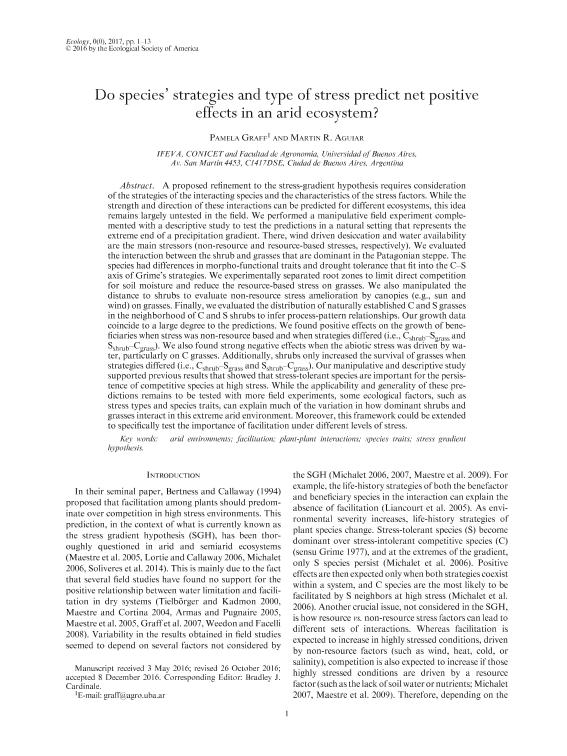Artículo
Do species' strategies and type of stress predict net positive effects in an arid ecosystem?
Fecha de publicación:
03/2017
Editorial:
Ecological Society of America
Revista:
Ecology
ISSN:
0012-9658
e-ISSN:
1939-9170
Idioma:
Inglés
Tipo de recurso:
Artículo publicado
Clasificación temática:
Resumen
A proposed refinement to the stress-gradient hypothesis requires consideration of the strategies of the interacting species and the characteristics of the stress factors. While the strength and direction of these interactions can be predicted for different ecosystems, this idea remains largely untested in the field. We performed a manipulative field experiment complemented with a descriptive study to test the predictions in a natural setting that represents the extreme end of a precipitation gradient. There, wind driven desiccation and water availability are the main stressors (non-resource and resource-based stresses, respectively). We evaluated the interaction between the shrub and grasses that are dominant in the Patagonian steppe. The species had differences in morpho-functional traits and drought tolerance that fit into the C-S axis of Grime's strategies. We experimentally separated root zones to limit direct competition for soil moisture and reduce the resource-based stress on grasses. We also manipulated the distance to shrubs to evaluate non-resource stress amelioration by canopies (e.g., sun and wind) on grasses. Finally, we evaluated the distribution of naturally established C and S grasses in the neighborhood of C and S shrubs to infer process-pattern relationships. Our growth data coincide to a large degree to the predictions. We found positive effects on the growth of beneficiaries when stress was non-resource based and when strategies differed (i.e., Cshrub-Sgrass and Sshrub-Cgrass). We also found strong negative effects when the abiotic stress was driven by water, particularly on C grasses. Additionally, shrubs only increased the survival of grasses when strategies differed (i.e., Cshrub-Sgrass and Sshrub-Cgrass). Our manipulative and descriptive study supported previous results that showed that stress-tolerant species are important for the persistence of competitive species at high stress. While the applicability and generality of these predictions remains to be tested with more field experiments, some ecological factors, such as stress types and species traits, can explain much of the variation in how dominant shrubs and grasses interact in this extreme arid environment. Moreover, this framework could be extended to specifically test the importance of facilitation under different levels of stress.
Archivos asociados
Licencia
Identificadores
Colecciones
Articulos(IFEVA)
Articulos de INST.D/INV.FISIOLOGICAS Y ECO.VINCULADAS A L/AGRIC
Articulos de INST.D/INV.FISIOLOGICAS Y ECO.VINCULADAS A L/AGRIC
Citación
Graff, Barbara Pamela; Aguiar, Martin Roberto; Do species' strategies and type of stress predict net positive effects in an arid ecosystem?; Ecological Society of America; Ecology; 98; 3; 3-2017; 794-806
Compartir
Altmétricas




